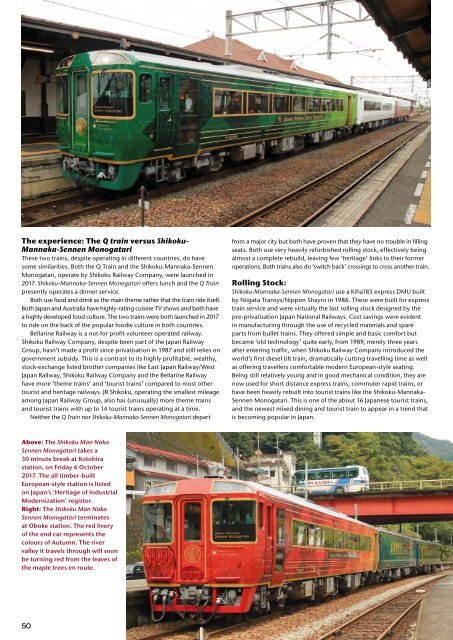Railway_Digest__February_2018
Create successful ePaper yourself
Turn your PDF publications into a flip-book with our unique Google optimized e-Paper software.
The experience: The Q train versus Shikoku-<br />
Mannaka-Sennen Monogatari<br />
These two trains, despite operating in different countries, do have<br />
some similarities. Both the Q Train and the Shikoku-Mannaka-Sennen<br />
Monogatari, operate by Shikoku <strong>Railway</strong> Company, were launched in<br />
2017. Shikoku-Mannaka-Sennen Monogatari offers lunch and the Q Train<br />
presently operates a dinner service.<br />
Both use food and drink as the main theme rather that the train ride itself.<br />
Both Japan and Australia have highly-rating cuisine TV shows and both have<br />
a highly developed food culture. The two trains were both launched in 2017<br />
to ride on the back of the popular foodie culture in both countries.<br />
Bellarine <strong>Railway</strong> is a not-for profit volunteer operated railway.<br />
Shikoku <strong>Railway</strong> Company, despite been part of the Japan <strong>Railway</strong><br />
Group, hasn’t made a profit since privatisation in 1987 and still relies on<br />
government subsidy. This is a contrast to its highly profitable, wealthy,<br />
stock-exchange listed brother companies like East Japan <strong>Railway</strong>/West<br />
Japan <strong>Railway</strong>, Shikoku <strong>Railway</strong> Company and the Bellarine <strong>Railway</strong><br />
have more ‘theme trains’ and ‘tourist trains’ compared to most other<br />
tourist and heritage railways. JR Shikoku, operating the smallest mileage<br />
among Japan <strong>Railway</strong> Group, also has (unusually) more theme trains<br />
and tourist trains with up to 14 tourist trains operating at a time.<br />
Neither the Q Train nor Shikoku-Mannaka-Sennen Monogatari depart<br />
from a major city but both have proven that they have no trouble in filling<br />
seats. Both use very heavily refurbished rolling stock, effectively being<br />
almost a complete rebuild, leaving few ‘heritage’ links to their former<br />
operations. Both trains also do ‘switch back’ crossings to cross another train.<br />
Rolling Stock:<br />
Shikoku-Mannaka-Sennen Monogatari use a Kiha185 express DMU built<br />
by Niigata Transys/Nippon Shayro in 1986. These were built for express<br />
train service and were virtually the last rolling stock designed by the<br />
pre-privatisation Japan National <strong>Railway</strong>s. Cost savings were evident<br />
in manufacturing through the use of recycled materials and spare<br />
parts from bullet trains. They offered simple and basic comfort but<br />
became ‘old technology’ quite early, from 1989, merely three years<br />
after entering traffic, when Shikoku <strong>Railway</strong> Company introduced the<br />
world’s first diesel tilt train, dramatically cutting travelling time as well<br />
as offering travellers comfortable modern European-style seating.<br />
Being still relatively young and in good mechanical condition, they are<br />
now used for short distance express trains, commuter rapid trains, or<br />
have been heavily rebuilt into tourist trains like the Shikoku-Mannaka-<br />
Sennen Monogatari. This is one of the about 16 Japanese tourist trains,<br />
and the newest mixed dining and tourist train to appear in a trend that<br />
is becoming popular in Japan.<br />
Above: The Shikoku Man Naka<br />
Sennen Monogatari takes a<br />
30 minute break at Kotohira<br />
station, on Friday 6 October<br />
2017. The all timber-built<br />
European-style station is listed<br />
on Japan’s ‘Heritage of Industrial<br />
Modernization’ register.<br />
Right: The Shikoku Man Naka<br />
Sennen Monogatari terminates<br />
at Oboke station. The red livery<br />
of the end car represents the<br />
colours of Autumn. The river<br />
valley it travels through will soon<br />
be turning red from the leaves of<br />
the maple trees en route.<br />
50<br />
RAILWAY DIGEST


